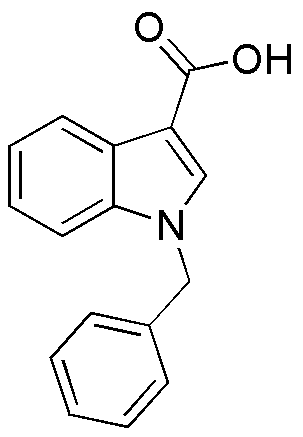1-Benzylindole-3-carboxylic acid is widely utilized in research focused on:
- Pharmaceutical Development: This compound serves as a precursor in the synthesis of various pharmaceuticals, particularly those targeting neurological disorders, due to its ability to interact with specific receptors in the brain.
- Biological Research: It is used in studies investigating the mechanisms of action of indole derivatives, helping researchers understand their potential therapeutic effects and biological activities.
- Material Science: The compound is explored in the development of advanced materials, such as polymers and coatings, owing to its unique chemical structure that enhances material properties.
- Agricultural Chemistry: It finds applications in formulating agrochemicals, where it can act as a bioactive agent, improving crop resilience and pest resistance.
- Analytical Chemistry: This chemical is employed as a standard in analytical methods, aiding in the detection and quantification of similar compounds in complex mixtures.
General Information
Properties
Safety and Regulations
Applications
1-Benzylindole-3-carboxylic acid is widely utilized in research focused on:
- Pharmaceutical Development: This compound serves as a precursor in the synthesis of various pharmaceuticals, particularly those targeting neurological disorders, due to its ability to interact with specific receptors in the brain.
- Biological Research: It is used in studies investigating the mechanisms of action of indole derivatives, helping researchers understand their potential therapeutic effects and biological activities.
- Material Science: The compound is explored in the development of advanced materials, such as polymers and coatings, owing to its unique chemical structure that enhances material properties.
- Agricultural Chemistry: It finds applications in formulating agrochemicals, where it can act as a bioactive agent, improving crop resilience and pest resistance.
- Analytical Chemistry: This chemical is employed as a standard in analytical methods, aiding in the detection and quantification of similar compounds in complex mixtures.
Documents
Safety Data Sheets (SDS)
The SDS provides comprehensive safety information on handling, storage, and disposal of the product.
Product Specification (PS)
The PS provides a comprehensive breakdown of the product’s properties, including chemical composition, physical state, purity, and storage requirements. It also details acceptable quality ranges and the product's intended applications.
Certificates of Analysis (COA)
Search for Certificates of Analysis (COA) by entering the products Lot Number. Lot and Batch Numbers can be found on a product’s label following the words ‘Lot’ or ‘Batch’.
*Catalog Number
*Lot Number
Certificates Of Origin (COO)
This COO confirms the country where the product was manufactured, and also details the materials and components used in it and whether it is derived from natural, synthetic, or other specific sources. This certificate may be required for customs, trade, and regulatory compliance.
*Catalog Number
*Lot Number
Safety Data Sheets (SDS)
The SDS provides comprehensive safety information on handling, storage, and disposal of the product.
DownloadProduct Specification (PS)
The PS provides a comprehensive breakdown of the product’s properties, including chemical composition, physical state, purity, and storage requirements. It also details acceptable quality ranges and the product's intended applications.
DownloadCertificates of Analysis (COA)
Search for Certificates of Analysis (COA) by entering the products Lot Number. Lot and Batch Numbers can be found on a product’s label following the words ‘Lot’ or ‘Batch’.
*Catalog Number
*Lot Number
Certificates Of Origin (COO)
This COO confirms the country where the product was manufactured, and also details the materials and components used in it and whether it is derived from natural, synthetic, or other specific sources. This certificate may be required for customs, trade, and regulatory compliance.


